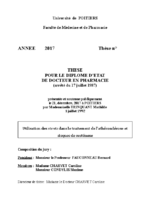Thèse d'exercice
Trinquant Mathilde
Utilisation des stents dans le traitement de l’athérosclérose et risques de resténose
FrançaisConsulter le texte intégral (format PDF)

Résumé
Français
Utilisation des stents dans le traitement de l’athérosclérose et risques de resténose
L'arrivée des stents sur le marché des dispositifs médicaux a modifié la prise en charge des patients souffrant de pathologie cardiaque, l'athérosclérose. En effet, suite à l'approfondissement des connaissances des acteurs (les cellules musculaires lisses, les lymphocytes, les macrophages, les cellules endothéliales) agissant dans la formation de la plaque d'athérome physiologique et les cellules endothéliales) agissant dans la formation de la plaque d'athérome physiologique et dans certains cas, de l'athérosclérose pathologique, la prise en charge des patients a été améliorée. Dans un premier temps, une angioplastie était pratiquée, complétée par une prise en charge médicamenteuse sur le long terme, afin d’assurer une revascularisation durable de la coronaire concernée. Malgré cette prise en charge, la menace de l'apparition d'une resténose était forte. Ce fut donc un axe d'amélioration dans la stratégie thérapeutique de cette maladie.
L'utilisation des stents dans cette pathologie a débuté avec les stents nus pour éviter l'apparition de la resténose. Des premiers résultats concluant ont été constatés dans cette prise en charge. Au vu de cette première réussite contre l'apparition de la resténose, les caractéristiques du stent, comme la taille ou encore le design, ont été améliorées. L'amélioration majeure réside dans l'utilisation d'une substance active directement logée au sein du dispositif médical afin d'agir
efficacement au niveau local pour éviter des complications. Ce dernier type de stent a entrainé un bénéfice clinique majeur en matière de santé publique. En effet, par de nombreuses études menées par des experts dans le domaine, ces stents ont prouvé qu’ils réduisaient l'incidence de la resténose chez la majorité des patients et améliorait leur qualité de vie.
Cependant, bien que les stents aient permis une prise en charge très satisfaisante de l'athérosclérose, des inconvénients subsistent : leur coût reste élevé, et la prise en charge demeure délicate, car elle doit être adaptée au type de patients lui-même.
Mots-clés libres : pathologie coronarienne, athérosclérose, plaque d'athérome, angioplastie, stent, resténose.
- Athérosclérose
- Angioplastie
English
The arrival of stents in the market of medical devices has modified the management of patients suffering from cardiac pathology, atherosclerosis. Indeed, with the deepening of the knowledge of the actors in the formation of physiological atheroma plaques (smooth muscle cells, lymphocytes, macrophages, endothelial cells) and in some cases pathological atherosclerosis, the management of patients has been improved. Initially, angioplasty was performed, supplemented by long-term medication management to ensure a permanent revascularization of the coronary concerned. Despite this management, the threat of the appearance of restenosis was high. It was therefore an axis of improvement in the therapeutic strategy for this disease.
The use of stents in this pathology began with bare stents to avoid the appearance of restenosis. In this case, initial results were found promising. With this first success against the appearance of the restenosis, the characteristics of the stent, like the size or the design, have been improved. The major improvement is the use of an active substance directly housed within the medical device in order to act effectively at the local level to avoid complications. This last type of stent has resulted in a major clinical benefit in terms of public health. Indeed, numerous studies carried out by experts in this field reported that these stents were proved to reduce the incidence of restenosis in the majority of patients and improve their quality of life.
However, despite stents have allowed a very satisfactory management of atherosclerosis, disadvantages remain: their cost stay high, and the management is still difficult to be adapted to the type of patients itself.
Keywords : coronary artery disease, atherosclerosis, atheromatous plaque, angioplasty, stent, restenosis.
Notice
- Diplôme :
- Diplôme d'état de Pharmacie
- Établissement de soutenance :
- Université de Poitiers
- UFR, institut ou école :
- Domaine de recherche :
- Pharmacie
- Directeur(s) du travail :
- Caroline Charvet
- Date de soutenance :
- 21 décembre 2017
- Président du jury :
- Bernard Fauconneau
- Membres du jury :
- Maxime Condylis
Menu :
-
-
à propos d'UPétille
-
Voir aussi
Annexe :

-
Une question ?
Avec le service Ubib.fr, posez votre question par chat à un bibliothécaire dans la fenêtre ci-dessous ou par messagerie électronique 7j/7 - 24h/24h, une réponse vous sera adressée sous 48h.
Accédez au formulaire...
Université de Poitiers - 15, rue de l'Hôtel Dieu - 86034 POITIERS Cedex - France - Tél : (33) (0)5 49 45 30 00 - Fax : (33) (0)5 49 45 30 50
petille@support.univ-poitiers.fr -
Crédits et mentions légales
